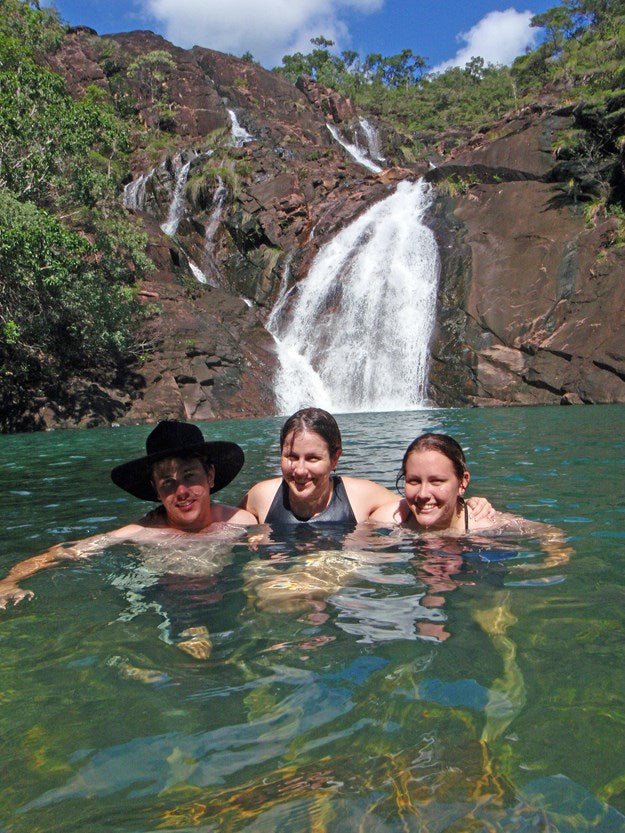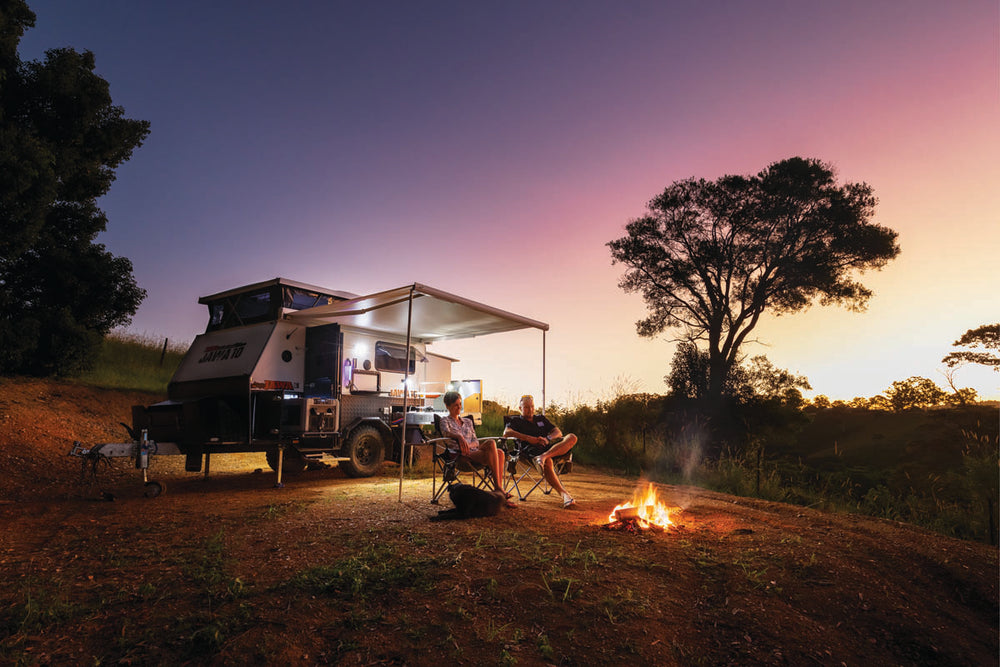Forrest Beach FNQ

Do you view the road-trip up the North Queensland coast as one that's strictly as straight and narrow? A direct route to your regular winter getaway, or a just series of links between major tropical tourist hotspots? Many of us stick resolutely to Highway One, blinkers firmly in place, steaming unknowingly past dozens of potentially delightful detours. Detours that could take us through amazing countryside to places just far enough out of the way to be a little bit different and interesting. Detours that reveal the day-to-day life of regional North Queenslanders you won’t see in the major tourist centres. Places where locals holiday and travellers often pull up for a night and stay for a week or more.
I have to admit I’m as guilty as everyone else. We usually drive straight through the sugar town of Ingham, bound for points further north. However, a family function at Ingham’s Forrest Beach Hotel inspired a detour to a small caravan park beside the pub overlooking the beach that got us hankering for more.
BOUND FOR FORREST BEACH
Like the best of detours, this one requires just a minimum of backtracking. Simply turn right at the first set of traffic lights as you approach Ingham from the south and eventually rejoin the highway 80kms later and around 10kms north of town. In between you’ll wander along good, sealed, country roads and visit three waterfront townships, all catering for travellers to varying degrees.
On the first leg to Forrest Beach let your GPS guide you through the outskirts of Ingham and out into the fields of swaying sugar cane. During the crushing season (approximately May to December) chances are you’ll see harvesters cutting the crop and cane trains hauling bins of chopped cane to the mill for processing into raw sugar. You’ll pass Victoria Sugar Mill, Wilmar Sugar’s largest Australian sugar mill, before driving through cattle country and arriving at Forrest Beach.
The township of Forrest Beach (also known as Allingham) has most of the basic facilities travellers need, including a supermarket, news-agency, takeaway, chemist and doctor’s surgery, not to mention the pub and caravan park. Life in Forrest Beach revolves around the local beach which is patrolled by the surf lifesaving club and features a stinger-protection enclosure for swimmers. A well-maintained, shady, foreshore park includes a playground, picnic shelters with tables and chairs, barbecues, showers and toilets. A boat ramp leads into the open sea allowing skippers to access local waters when conditions are favourable. For those with larger boats the waters around the Palm Islands (20kms offshore) and the Great Barrier Reef are popular fishing spots.
Besides the fishing (which locals say is good even just off the beach) other activities at Forrest Beach are pleasantly limited. The 14kms-long, sandy beach beckons those who enjoy a brisk (or a leisurely) walk and just a short stroll south of the caravan park avid twitchers will find tea tree swamps behind the sand dunes which are alive with birdlife. However, I would caution against approaching too close to the swamps as they look like prime crocodile territory to me. Pack your binoculars and do your bird-watching from a safe distance.
The Forrest Beach Hotel and Caravan Park is probably best described as an old-fashioned, basic park. It doesn’t have a barbecue, camp kitchen, pool, recreation room or kiosk, but it makes up for these shortcomings with its prime beachfront position (with uninterrupted views to the Palm Islands) and a friendly, country pub serving cold beer and tasty meals just next door. And for light sleepers, this park is magic. It is easily the quietest caravan park we have ever stayed in. With not a hint of traffic noise and the cooling sea breezes meaning the drone of air-conditioners was rarely heard, we were lulled to sleep by just the distant, barely-audible sound of waves lapping the beach.
Like most North Queensland parks, this one is packed during the peak winter season. We visited in early-Spring and found the temperatures comfortable but the park almost empty, with most of the southern nomads already heading for the cooler climes of home. A few were hanging back, squeezing every, sun-drenched day they could from their FNQ escape. One long-termer in the process of breaking camp after four months told us he “might go next week …maybe”.
The park has 52 powered sites (many shaded by coconut palms or the fringing bushland) as well as a large grassed area with unpowered sites for up to 200 campers tucked behind the sand dunes.
To be honest, this park could easily have benefited from a bit more maintenance – a bit of care and attention. Mind you, our visit was comfortable enough and we weren’t complaining about the basic facilities.
TAYLORS BEACH
From Forrest Beach the next 32kms leg of our detour took us to Taylors Beach, further up the coast.
The township of Taylors Beach is situated on the north bank of Victoria Creek with the Taylors Beach Caravan Park just 400 metres from the boat ramp and beach.
As well as powered and unpowered sites ($36 and $28 a night respectively) the caravan park provides most of the facilities travellers expect—and then some. There is a covered barbecue area and camp kitchen with all the appliances, plus a 55in TV with Foxtel, a fish filleting station, two amenity blocks, a large pool, free Wi-Fi and a dump point. Other services provided in the park include bait and fishing tackle supplies, hardware, Australia Post Agency, Engel retail agency, ice, LPG refills, unleaded and diesel fuel, a mini-mart, a free book exchange and trips to the reefs and islands can be arranged. Keen anglers can even hire a boat to explore, fish and crab the 17kms of estuarine waterways that make up Victoria Creek.
While the excellent, two-lane launching ramp might be all-weather, it does not appear to be all-tidal, with plenty of sand exposed at low tide. Just scanning the creek mouth from the shore, I got the impression Victoria Creek might be a challenge to navigate on a dead low tide and I would suggest visiting anglers should seek a bit of local knowledge before hitting the water.
The foreshore near the boat ramp is a great spot to sit and enjoy the view across Victoria Inlet and to the islands beyond. This shady strip of land is dotted with walking paths, picnic areas, free gas barbecues, park benches, toilets and even rod holders for beach fishers keen to catch dinner.
Commitments further north meant we didn’t have time to enjoy all that Taylors Beach has to offer, but you can see why it is definitely on our list for our next wander along the North Queensland coast.
LOVELY LUCINDA
From Taylors Beach we meandered through paddocks of sugar cane to the tiny township of Halifax and then on through acres of mangrove forests to the end of the road at Lucinda.
This picturesque spot is popular with tourists and locals and can become quite busy during the peak winter season and on any of the long weekends. Located on the mainland foreshore opposite the southern end of the World Heritage-listed Hinchinbrook Island, Lucinda offers good access to some of the most spectacular boating and fishing in North Queensland.
The Wanderers Holiday Village is the only caravan park at Lucinda. It’s a large park with correspondingly large sites that can accommodate big rigs. The park has 148 powered sites at $38 per couple and eight grassed, unpowered sites costing $31 per couple. The park is located just a short walk from a convenience and takeaway store which also sells unleaded and diesel fuel and bait.
Facilities include a dump point, a basic camp kitchen, a fish cleaning shed, freezer storage for fish scraps and bait and a delightful, tropical pool. Recreational activities include table tennis, beach volley ball and bocce and, during the peak period, golf competitions and craft mornings.
However, fishing is the main activity of visitors and excellent launching facilities are located at Dungeness, just a few minutes from the caravan park.
For those with a boat Lucinda’s sugar loading jetty is like a magnet to both fish and fishers, stretching seawards for 5.7kms. With the end of the jetty sitting in almost 20m of water anglers can expect to tangle with a range of bluewater pelagic and bottom species.
Equally beckoning is Hinchinbrook Island and the labyrinth of estuarine creeks separating it from the mainland. When the weather is calm, larger boats can venture around to picturesque Zoe Bay on the seaward side of Hinchinbrook Island for a swim under the magnificent waterfall on South Zoe Creek.
Landbased anglers can wet a line from the beach beside the sugar loading jetty or from the service jetty which is accessible via a walkway from the caravan park.
Other options to get afloat if you don’t have a boat are houseboat hire at Dungeness, guided fishing trips and charter boat and ferry trips to explore parts of Hinchinbrook Island, Australia’s largest island National Park. Ask at the caravan park office for further information.
From Lucinda we retraced our path back to Halifax and eventually to the highway north. It had been a largely unplanned detour not that far from the main highway, but we had wandered through countryside and visited townships and fishing villages that many travellers miss. Our short detour had left us with a better appreciation of yet another scenic slice of normally-unseen, Tropical North Queensland.
Shed the blinkers and dare to detour—you won’t be sorry.
FAST FACTS
Commence your 80km detour at Ingham, 113km north of Townsville.
For Forrest Beach Hotel Caravan Park, email info@forrestbeachhotel.com.au or phone (07) 47778700
For Taylors Beach Holiday Park phone (07) 47778560
For Wanderers Holiday Village Lucinda, phone (07) 47778213







